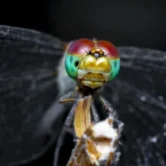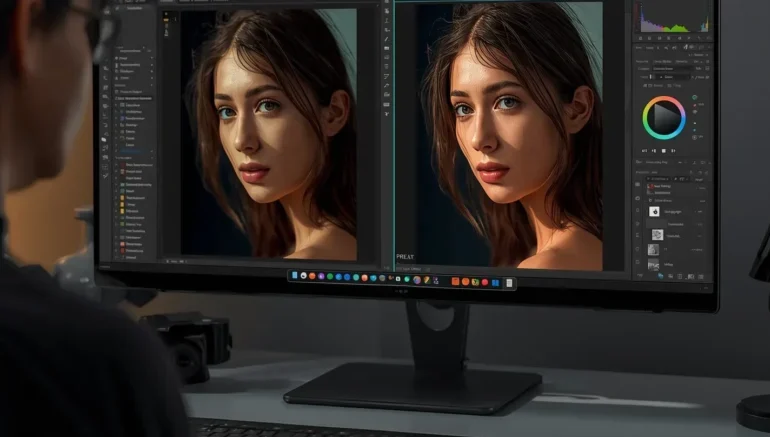
Top 10 Reasons AI Still Needs Manual Editing for Perfect Photos
AI photo editing tools are improving quickly, and they can fix colors, remove backgrounds, and adjust lighting in seconds. But no matter how advanced AI becomes, it still can’t replace the human touch. This is where Manual Editing for Perfect Photos comes in. Human editors notice small details, simple tones, and artistic choices that AI often misses. With manual editing, every photo can reach its full potential and look truly professional.
AI is great for handling large batches of images or quick fixes, but it often creates results that feel too uniform or artificial. Manual editing allows photographers and editors to add creativity, correct tiny flaws, and maintain natural looks. It makes sure that every shadow, highlight, and color is just right. In this article, we’ll explore the top 10 reasons why AI still needs manual editing to make photos truly perfect. By understanding these reasons, you’ll see why combining technology with human skill gives the best results.
Manual Editing for Perfect Photos Gets the Details Right
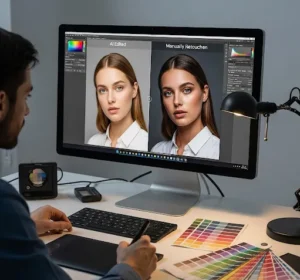 AI tools are great at handling basic photo edits. They can adjust brightness, fix colors, remove simple backgrounds, and even sharper images with just a click. For photographers dealing with large batches of photos, this can save a lot of time. However, AI often misses small details that can make a big difference. Tiny imperfections, soft textures, or small objects in the background may be overlooked. That’s why relying only on AI can leave your photos looking unfinished or too generic.
AI tools are great at handling basic photo edits. They can adjust brightness, fix colors, remove simple backgrounds, and even sharper images with just a click. For photographers dealing with large batches of photos, this can save a lot of time. However, AI often misses small details that can make a big difference. Tiny imperfections, soft textures, or small objects in the background may be overlooked. That’s why relying only on AI can leave your photos looking unfinished or too generic.
Manual editing fills in these gaps and makes every detail is correct. Human editors can spot inconsistencies that AI cannot predict and make precise adjustments to improve the overall look of a photo. For example, shadows, reflections, or delicate patterns often need a careful touch.
Here are some tips for readers to improve their photos after AI fixes:
- Check for small objects or distractions in the background
- Adjust tiny color differences that AI may have missed
- Refine edges and fine details for a sharper, cleaner look
- Make simple adjustments to shadows and highlights for balance
Why Manual Editing for Perfect Photos Sees What AI Often Misses
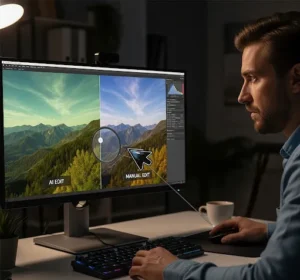 No matter how advanced AI becomes, it still can’t fully match the human eye. Machines follow algorithms and patterns, but they don’t understand context or notice small details the way humans do. This means soft differences in color, texture, or light can go unnoticed. For example, a shadow that slightly changes the mood of a photo or a tiny detail in a product image may be missed by AI. Human editors can carefully examine each photo and correct these small imperfections to make images look natural and polished.
No matter how advanced AI becomes, it still can’t fully match the human eye. Machines follow algorithms and patterns, but they don’t understand context or notice small details the way humans do. This means soft differences in color, texture, or light can go unnoticed. For example, a shadow that slightly changes the mood of a photo or a tiny detail in a product image may be missed by AI. Human editors can carefully examine each photo and correct these small imperfections to make images look natural and polished.
Using your own eyes during manual editing also helps maintain consistency across multiple photos. Human judgment allows you to adjust images based on what feels right, rather than what a machine assumes is correct.
Here are some tips for readers to catch what machines often miss:
- Zoom in to check fine details in textures and edges
- Look for color variations that seem unnatural or off-balance
- Inspect shadows and highlights for realism
- Review backgrounds for small distractions or mistakes
Creativity Matters and AI Can’t Decide
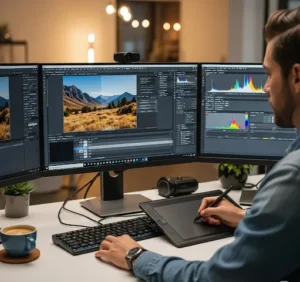 AI can follow rules and patterns, but it cannot think creatively or make artistic decisions. It can adjust colors, fix lighting, or sharpen an image, but it doesn’t understand the mood, style, or story behind a photo. This is where human creativity becomes important. Manual editing lets you add personal touches, emphasize key areas, or experiment with effects that give a photo character and uniqueness. Without this creative input, images may look flat, repetitive, or too generic. Human editors can make choices that highlight emotion, style, or the story a photo wants to tell.
AI can follow rules and patterns, but it cannot think creatively or make artistic decisions. It can adjust colors, fix lighting, or sharpen an image, but it doesn’t understand the mood, style, or story behind a photo. This is where human creativity becomes important. Manual editing lets you add personal touches, emphasize key areas, or experiment with effects that give a photo character and uniqueness. Without this creative input, images may look flat, repetitive, or too generic. Human editors can make choices that highlight emotion, style, or the story a photo wants to tell.
Using creativity in manual editing also helps bring balance and focus to your images. You can guide the viewer’s eye, adjust elements for harmony, and upgrade the overall feel of the photo.
Here are some tips for adding creative touches:
- Play with color grading to create a specific mood
- Highlight important parts of the image to draw attention
- Use selective edits for depth and emphasis
- Add soft artistic effects that complement the subject
Natural Skin and Colors Need a Human Touch
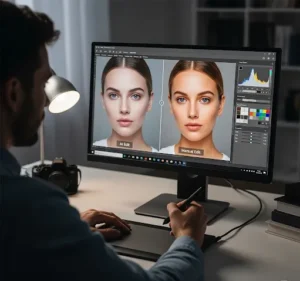 AI can adjust colors and smooth skin automatically, but it often produces results that look unnatural or too perfect. Human skin has soft tones, textures, and variations that AI may not recognize. Manual editing allows you to carefully balance these details, keeping skin looking healthy and realistic. This is especially important for portraits, beauty shots, and professional headshots, where small color or tone errors can be very noticeable. Human editors can also make sure colors across the entire image are harmonious and consistent, which AI sometimes misses.
AI can adjust colors and smooth skin automatically, but it often produces results that look unnatural or too perfect. Human skin has soft tones, textures, and variations that AI may not recognize. Manual editing allows you to carefully balance these details, keeping skin looking healthy and realistic. This is especially important for portraits, beauty shots, and professional headshots, where small color or tone errors can be very noticeable. Human editors can also make sure colors across the entire image are harmonious and consistent, which AI sometimes misses.
Manual editing gives you the control to refine colors and skin tones without losing the natural feel of the photo. By paying attention to small details, you can create images that are professional and visually pleasing.
Here are some tips for handling skin and colors manually:
- Adjust skin tones carefully to avoid over-smoothing
- Check color balance to maintain natural lighting
- Compare different areas of the photo to assure consistency
- Make simple corrections rather than drastic changes
Shadows and Highlights Require Careful Adjustments
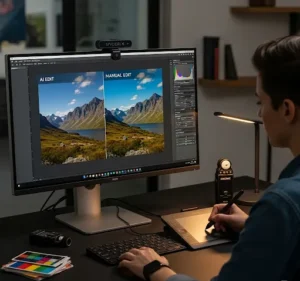 Shadows and highlights play a big role in how a photo looks, but AI often struggles to get them just right. It can brighten or darken areas automatically, but this may lead to overexposed highlights or crushed shadows. Manual editing allows you to adjust these areas carefully, keeping the photo balanced and natural. Proper control of shadows and highlights can bring out textures, add depth, and make the image more realistic. Without this attention, photos may look flat, harsh, or uneven. Human editors can evaluate each section of the image and make precise corrections that AI cannot predict.
Shadows and highlights play a big role in how a photo looks, but AI often struggles to get them just right. It can brighten or darken areas automatically, but this may lead to overexposed highlights or crushed shadows. Manual editing allows you to adjust these areas carefully, keeping the photo balanced and natural. Proper control of shadows and highlights can bring out textures, add depth, and make the image more realistic. Without this attention, photos may look flat, harsh, or uneven. Human editors can evaluate each section of the image and make precise corrections that AI cannot predict.
Careful adjustment of light also helps maintain the mood and focus of the photo. By fine-tuning shadows and highlights, you can guide the viewer’s eye and emphasize the subject effectively.
Here are some tips for managing shadows and highlights manually:
- Use selective adjustments instead of global changes to keep details intact
- Avoid over-brightening highlights or darkening shadows too much
- Check different parts of the image for balance and consistency
- Experiment with simple contrast adjustments to add depth
Correcting Tiny Flaws That AI Overlooks
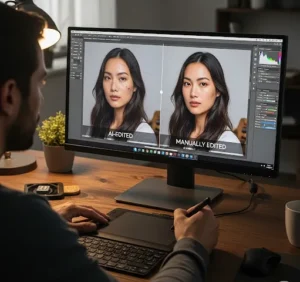 AI can handle major edits quickly, but it often misses small flaws that affect the overall quality of a photo. Tiny dust spots, stray objects, or small blemishes can go unnoticed by automated tools. Manual editing allows you to carefully examine every part of the image and correct these imperfections. Paying attention to minor details too make sure that your photos look polished, professional, and clean. Even small corrections can make a big difference in how the final image is perceived. Human editors can also adjust fine lines, edges, and textures that AI might overlook, adding a level of precision that machines cannot replicate.
AI can handle major edits quickly, but it often misses small flaws that affect the overall quality of a photo. Tiny dust spots, stray objects, or small blemishes can go unnoticed by automated tools. Manual editing allows you to carefully examine every part of the image and correct these imperfections. Paying attention to minor details too make sure that your photos look polished, professional, and clean. Even small corrections can make a big difference in how the final image is perceived. Human editors can also adjust fine lines, edges, and textures that AI might overlook, adding a level of precision that machines cannot replicate.
Focusing on these tiny flaws improves the overall impact of your photos and helps maintain consistency across multiple images.
Here are some tips for spotting and correcting small issues:
- Zoom in closely to check for dust, scratches, or tiny objects in the background
- Remove minor blemishes on skin or surfaces for a cleaner look
- Smooth out uneven textures without over-editing
- Compare before and after edits to make sure changes look natural
- Pay attention to edges and fine details for a polished finish
Consistency for Multiple Images Demands Human Control
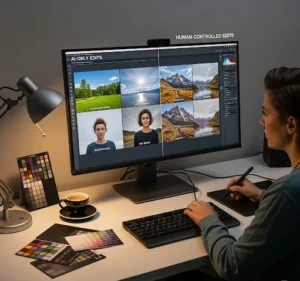 When working with multiple photos from the same shoot, AI can provide quick edits, but it often struggles to keep everything consistent. Colors, lighting, and exposure may vary slightly from one image to another, which can create a disjointed look. Manual editing allows human editors to make sure that every photo in a set matches in tone, brightness, and style. This is especially important for product catalogs, portfolios, or social media feeds where a cohesive look matters. By carefully reviewing each image, editors can create a uniform appearance that AI alone cannot guarantee.
When working with multiple photos from the same shoot, AI can provide quick edits, but it often struggles to keep everything consistent. Colors, lighting, and exposure may vary slightly from one image to another, which can create a disjointed look. Manual editing allows human editors to make sure that every photo in a set matches in tone, brightness, and style. This is especially important for product catalogs, portfolios, or social media feeds where a cohesive look matters. By carefully reviewing each image, editors can create a uniform appearance that AI alone cannot guarantee.
Consistency helps your work appear professional and visually appealing. Maintaining a consistent style also strengthens your personal or brand identity. Human control makes sure that small differences are corrected and that the overall feel of the images aligns with your vision.
Here are some tips for keeping multiple images consistent:
- Compare photos side by side to spot differences in color and lighting
- Apply manual adjustments to match tones across all images
- Use reference images as a guide for style and exposure
- Check shadows, highlights, and contrast for uniformity
- Make small adjustments rather than large automated changes for better control
Specialized Photography Needs Expert Handling
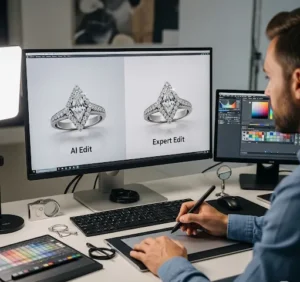 Some types of photography require very precise and careful editing that AI alone cannot handle. Product shots, jewelry, food, and fashion photography often have small details that need expert attention. AI might remove or blur fine textures, misplace reflections, or create unnatural results. Manual editing allows experts to refine these elements, making the final image looks professional and true to life. Human editors can improve details, adjust reflections, and correct imperfections that machines may miss. This level of care is important for images that will be used for marketing, e-commerce, or professional portfolios.
Some types of photography require very precise and careful editing that AI alone cannot handle. Product shots, jewelry, food, and fashion photography often have small details that need expert attention. AI might remove or blur fine textures, misplace reflections, or create unnatural results. Manual editing allows experts to refine these elements, making the final image looks professional and true to life. Human editors can improve details, adjust reflections, and correct imperfections that machines may miss. This level of care is important for images that will be used for marketing, e-commerce, or professional portfolios.
Specialized photography also demands a deep understanding of the subject and the desired outcome. Knowing how to highlight important details or create the right mood can make a big difference in the image’s impact.
Here are some tips for handling specialized photos manually:
- Focus on small, critical details like textures, reflections, and patterns
- Use selective editing tools to improve only necessary areas
- Maintain accurate colors, especially for products and food
- Pay attention to lighting and shadows for realism
- Review the final image closely to assure nothing is distorted or missing.
AI Can’t Understand Intent or Mood
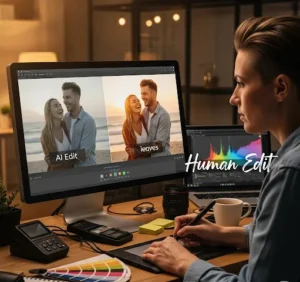 AI can process images and apply edits based on rules, but it cannot understand the story, intent, or mood behind a photo. The feeling a photographer wants to convey, if it’s warmth, drama, or calmness, often requires careful manual adjustments. Small changes in color, lighting, or focus can completely change how a photo is perceived, and AI may not make these choices correctly. Manual editing allows human editors to interpret the photographer’s vision and improve the mood intentionally. This makes sure that the final image communicates the right emotion and connects with viewers.
AI can process images and apply edits based on rules, but it cannot understand the story, intent, or mood behind a photo. The feeling a photographer wants to convey, if it’s warmth, drama, or calmness, often requires careful manual adjustments. Small changes in color, lighting, or focus can completely change how a photo is perceived, and AI may not make these choices correctly. Manual editing allows human editors to interpret the photographer’s vision and improve the mood intentionally. This makes sure that the final image communicates the right emotion and connects with viewers.
Understanding intent and mood also helps maintain consistency across a series of images or a project. Human editors can make choices that highlight key elements or create atmosphere without losing natural look.
Here are some tips for maintaining intent and mood during manual editing:
- Adjust color tones to reflect the desired emotion
- Control lighting and shadows to set the atmosphere
- Emphasize subjects or key areas to guide the viewer’s focus
- Avoid over-editing, which can distort the intended mood
- Review the image multiple times to assure the feeling comes through
Combining AI and Manual Editing for Perfect Photos
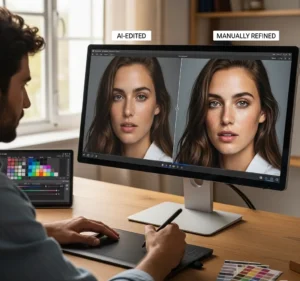 AI and manual editing each have their strengths, and combining them can produce the best results. AI is fast and efficient for handling repetitive tasks like basic color correction, background removal, or initial adjustments. Manual editing adds the human touch that makes details, textures, and moods are perfect. By using both, photographers and editors can save time without compromising quality. This approach allows for a smoother workflow, where AI handles the simple work and humans focus on creativity and precision. The result is photos that are polished, professional, and visually appealing.
AI and manual editing each have their strengths, and combining them can produce the best results. AI is fast and efficient for handling repetitive tasks like basic color correction, background removal, or initial adjustments. Manual editing adds the human touch that makes details, textures, and moods are perfect. By using both, photographers and editors can save time without compromising quality. This approach allows for a smoother workflow, where AI handles the simple work and humans focus on creativity and precision. The result is photos that are polished, professional, and visually appealing.
Using a combined approach also gives more control over the final look while keeping efficiency high. Human editors can review AI’s work, correct any errors, and improve important areas.
Here are some tips for making the most of both methods:
- Start with AI for basic adjustments and batch edits
- Use manual editing to refine details, textures, and colors
- Check the overall mood and intent of the photo
- Make selective adjustments to shadows, highlights, and fine details
- Review the final image carefully to assure balance and consistency
Conclusion
AI photo editing tools are powerful and can save a lot of time, but they still cannot replace the precision, creativity, and judgment of a human editor. Manual Editing for Perfect Photos makes sure that every detail, color, and mood is just right, giving your images a professional and natural look. Combining AI and manual editing creates the best results, blending speed with quality and creativity. By paying attention to small flaws, consistency, and artistic choices, your photos can stand out and truly reflect your vision. What do you think; do you prefer using AI, manual editing, or a mix of both in your workflow? Share your thoughts and experiences in the comments below, we’d love to hear how you make your photos perfect.
Read Next: 5 Proven Benefits of Human Touch in AI-Edited Photos





